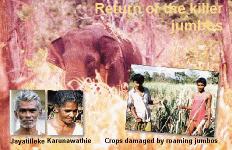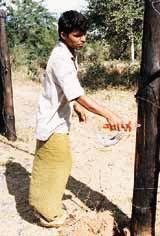 Year on the Web
Year on the Web Year on the Web
Year on the Web



Return of the Killer Jumbos(Larger picture)Pix. by Kumara Dayawansa |
Contents
|
The article The need of the hour which appeared in The Sunday Times of February 23, was by Dr. Kalhari Hewage, Consultant Psychologist, Ruhuna University. We regret the omission of the credit
For the people of Handapanagala, the nightmare has begun again. As dusk falls, villagers hurry back to their homes, not daring to go about when the elephants break into their cultivations. Yes, the elephants are back. Although not in huge numbers like in earlier times before last year's controversial elephant drive, around 40 -50 animals have been sighted in the last few weeks.
They are often seen roaming along the electrified fence, that separates the village and plantation from the jungle, after dusk. At times they break through the fence running amok in the fields of hard grown, rain starved crops, destroying whatever has survived the long drought.
 Point
of entry: where elephants had broken in the night before
Point
of entry: where elephants had broken in the night before
"Yesterday elephants broke into my sugar cane plantation," K. D.
Kularathne said, walking among the broken plants, crushed under the elephants'
feet, leaves strewn about. "In one night they have destroyed more than
half acre." Kularatna's plantation consists of some two and a half acres of
suger cane. His property borders the roadway, which is next to the electrified
fence erected by the Pelwatte Sugar Company. Taking us to the fence, he pointed
to where the elephants had broken through the barrier the night before. The
poles were pushed apart, wires trampled and pulled down.
"I tried to scare them away by throwing stones and shouting and one tried to charge at me when the stones fell close to it."
Stories like this abound in the village. Once again, the Handapanagala herd is terrorizing the people sharing the land. The villagers say that the elephants had made their presence felt a couple of months ago. Gradually the numbers have increased and they were confined to the forest surrounding the picturesque Handapanagala tank. As the rains failed and food in the jungle became scarce, the elephants began to break into the cultivation. The elephant drive late last July to take the herd into Yala appeared successful at the time. But now, these animals have come back and for the villagers, the nightmare has recurred.
"After the drive, there were a few months of peace," Jayatileke, the mudalali of a tea shop at Handapanagala junction said.
"We cannot say whether they are the same animals or from a different herd, but definitely the elephant troubles have started again." Jayatileke's tobacco crop was attacked by jumbos the day before. Some villagers have identified certain lone animals as being ones who had attacked them before the drive.The animals, according to the description by the villagers are even more volatile than before.
"I was attacked during daylight while I was returning home from the junction," the elderly R. M. Somapala said. He said that he was coming home on his bicycle, when he had seen the elephant standing by the electric fence alongside the road. "It was 6.30 in the evening and still light. When he saw me, the animal became agitated and charged at me, tearing the fence." Somapala had run for his life and managed to escape. He had to be carried home by other villagers. His wife, Karunawathie said that their crops are attacked all the time by the beasts. The dry parched vegetable beds with some peanut and green chillie crops were flattened to the ground by the elephants.
"We keep vigil all night with a log fire burning, watching out for elephants," Kanthi said, inviting us into her wattle and daub house. "Our house was destroyed once by elephants, and we built another. Even this house is hardly any protection against the animals."
She said that two days earlier, a lone elephant had come through the fence and they were warned of it. "There is no end to our troubles," she cried. "I have three children, I have to consider their safety. I can't remember when I last had a night's sleep."
The villagers complain that the electric fence has no effect on the elephants. "Even we experience the shock when we sometimes creep through the fence. It feels like a small jolt. If a human is not hurt by the fence, will it keep an elephant away?" asked Somarathne, a farmer.
Every evening a Pelwatte Sugar Company tractor patrols the border by the electric fence, watching out for elephants who have broken through and attempting to chase them back into the forest. They told us that definitely more than 40 elephants have returned to the area. Trying to push back a bent post to its original position, the company workers said that they concentrate more on patrolling the border along their sugar cane plantations. Even this little protection is welcomed by the villagers, who otherwise would be left totally at the mercy of the hungry elephants.
The history of the Handapanagala herd has been so oft repeated, but in a nut shell, the large herd became trapped between the tank and the village, when the Pelwatte sugar cane plantations encroached upon the jungles that was their home. In hunger, lured by the sweet tasting sugar cane, the jumbos began to attack the villages and the plantation. This resulted in a bloody conflict of several years when some 70 villagers and 150 elephants died.
Contacted by The Sunday Times last week,The Director of the Wild Life Department said that he was yet unaware that there was a serious problem at Handapanagala. "I will look into the matter," he promised.
But suprisingly, the officials at Pelwatte Sugar said that they have had discussions with the Wild Life Department last week in a bid to resolve the present situation at Handapanagala.
" The Department promised to survey the situation immediately and conduct a mini drive to chase these elephants back to Yala," K. Rantilleke, Agriculture Manager of Pelwatte Sugar Company said.
He said that he had seen a herd of about 15 animals in the area, but said that no serious incidents have been reported as yet.
Meanwhile for the poor villagers who live alongside the fragile fence, their life has to go on, even if it means daily encounters with hungry jumbos.
"No one has been killed by the elephants yet," one villager told us wryly. "I suppose the authorities are waiting for that to happen to take action. Anyway that won't be long in the waiting now."
Trapped by the ever increasing sugar cane crops, elephants who earlier roamed the jungles of Uva are now venturing upwards into the mountainous areas.
Herds have been spotted in tea plantations in the lower reaches of the Haputale and Namunukula ranges for the last couple of years. Gradually as the settlements and plantations extend to their habitat, the jumbos have ventured further and further into the tea plantations.
A planter owner of the New Macaldeniya Estate, growing tea in Koslanda, above the Diyaluma falls complained that most nights elephants come into his estate, terrorize the workers and had even eaten up a plantain tree in his garden. Two weeks ago an estate worker was killed by an elephant.
"I have been here for 12 years. This problem started only two years ago," Raja Sithambaram said. He added that many other estates in that area are affected by this elephant menace.
The Department of Wild Life Conservation said that they have planned a drive to take these elephants away from the estate areas. They said that the drive will commence around mid March.
But other experts feel that the behavioral patterns of these elephants have to be studied more carefully to implement a long term solution to the problem.
"Elephants do not always come from Yala. They have their own complex routes. The origin of these herds have to be studied in order to confine them to a national park for good," said Jayantha Jayawardena, who works with the Southern Development Agency.
"It would be worth the effort, for the Department of Wild Life Conservation to study the patterns of behavior for an year or so before they implement ad hoc drives," he said.
Continue to Plus page 2 - Splendour of the splash * Third communication revolution, Part II: Gearing up for the race on the info highway






Please send your comments and suggestions on this web site to
info@suntimes.is.lk or to
webmaster@infolabs.is.lk